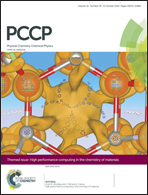Defect self-doped TiO2 for visible light activity and direct noble metal anchoring†
Abstract
A facile approach was developed for preparing defective, self-doped TiO2, which shows remarkable visible light activity in the photocatalytic degradation of RhB and hydrogen liberation from water. Moreover, noble metal was directly deposited onto the TiO2 surface via an in situ redox reaction between surficial Ti3+ and metal salt. The lack of involvement of foreign reducing agents or stabilizers permits intimate contact between metal nanoparticles and the TiO2 substrate, which ensures the facilitated interfacial charge transfer. The strategy presented in this work may be applied to design other defect and noble metal mediated visible-light-active photocatalysts.


 Please wait while we load your content...
Please wait while we load your content...